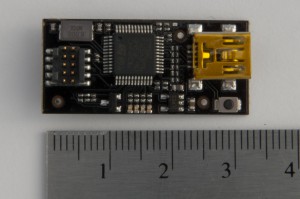 A few months ago I met a great guy Gareth MacMullin in the libopencm3 channel. He was working on a new Open-Source and Open-Hardware JTAG solution called Black Magic Probe(BMP). I got one of those and instantly fell in love with it.
A few months ago I met a great guy Gareth MacMullin in the libopencm3 channel. He was working on a new Open-Source and Open-Hardware JTAG solution called Black Magic Probe(BMP). I got one of those and instantly fell in love with it.
OpenOCD is great in a sense because it supports lots of targets and probes but that is its disadvantage too. It is very often difficult to set up and tends not to work properly in many cases. The approach of BMP is quite different. Instead of the probe being quite dumb and using OpenOCD to do the JTAG magic the BMP uses a microcontroller (STM32F1) and implements a GDB server inside the controller. This solution cuts out the middleman and talks JTAG as well as the new Serial Wire Debug (SWD) protocol itself. Requiring only a working GDB on the computer.
The BMP supports several Cortex-M3 targets and more devices are being added fairly quickly. The first time I tried it with an STM32 it just worked. No command line parameters just:
arm-none-eabi-gdb some_elf_file
target extended-remote /dev/ACM0
mon swdp_scan
att 1
load
run
It shocked me how fast the loading process was. Because it is not one of the FTDI chips and does not have to bitbang all of the JTAG protocol over USB it can run much much faster. I know there are commercial devices like JLink that have logic inside them but they cost arm and a leg if you don’t want to just get the educational version of it.
One more thing comes to mind when you realize that the BMP supports SWD. You only need three pins to be able to use it GND, SWDIO and SWCLK. That decreases the required real estate on the PCB significantly. I am not sure what the status of OpenOCD support for SWD is now but it is work in progress as far as I understand. On BMP it just works.
Since I started using the BMP there were several interesting developments that Gareth added. The BMP is not only offering one serial port for the GDB extended remote interface but also a second one providing a TTL level UART interface. The BMP also supports tracing by now using the TRACESWO pin. This provides a reasonably high speed tracing. Gareth also wrote a plotter for this feature that plots the contents of traced variables in your code.
Early versions of BMP were 2.5cm X 5cm the current version called Black Magic Probe Mini (BMPM) is smaller, the same size as the FLOSS-JTAG I made a while ago, it is mere 1.5cm X 3cm, packing in all the power of the BMP what makes it great for doing embedded stuff on the go, for example in the subway.
So to wrap things up, it is a high grade, Open-Source and Open-Hardware device. For $60 this thing is a steal!
Shameless plug: On 1 BIT SQUARED store you can order the Black Magic Probe.
There are also some other distributors listed on the BMP page too. So check it out! I bet you will love it. 🙂